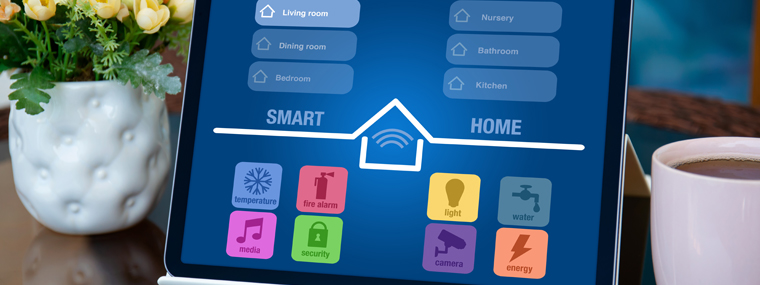
Is Your Home Really Smart?
By Kevin Brown / Published March 2024

The terms “smart devices” and “smart homes” have become increasingly prevalent. These phrases are often used interchangeably, leading to confusion about their true meaning and functionality. However, they are distinct concepts, each offering unique benefits and applications. This article aims to shed light on the key differences between smart devices and smart homes, elucidating their roles in shaping the modern connected lifestyle.
Smart devices, also known as the Internet of Things (IoT) devices, are gadgets and appliances embedded with advanced sensors, processors, and connectivity features, allowing them to communicate with other devices and the internet. These devices are designed to enhance convenience, efficiency, and connectivity in various aspects of everyday life. Examples of smart devices include smart speakers (e.g., Amazon Echo, Google Home), smart thermostats, smart lighting systems, smart locks, smart TVs, and smart appliances (e.g., refrigerators, washing machines).
Smart devices are equipped with Z-Wave, Wi-Fi, Bluetooth, Zigbee, or other wireless technologies, enabling them to establish connections with other smart devices and central hubs. These devices can be controlled remotely through dedicated apps on smartphones or tablets, allowing users to manage and monitor them from anywhere with an internet connection. Smart devices often feature voice control and integration with virtual assistants like Amazon Alexa or Google Assistant, providing a hands-free user experience. Smart devices typically operate independently and, in most cases, do not integrate with other devices, and this is where the difference lies. Yes, you can control independent smart devices remotely or through voice control. But, having separate devices, through separate apps, that do not communicate with each other makes them 100 percent reliant on you having to tell these devices to act every time.
A true smart home takes the concept of smart devices a step further by integrating multiple devices into a unified ecosystem controlled by a central automation system. This is where “if this, then that” (IFTTT) comes into play. This system orchestrates the interactions between devices, creating sophisticated routines and scenarios that enhance the efficiency and autonomy of the entire household. Automation enables seamless communication and coordination between smart devices, making the smart home a more cohesive and intelligent entity. This eliminates the dependency of you toggling between multiple apps and advising each device to take action as you would by having individual smart devices.
In a smart home with automation, various smart devices work together cohesively, sharing data and interacting in response to specific triggers or conditions. Users can set up automation routines based on predefined triggers, such as time of day, occupancy, or sensor readings.
For example, when the homeowner leaves the home, triggers such as geofencing parameters or scene selections tells the system to automatically adjust the thermostat, turn off the lights, and lock the doors. Automation reduces the need for manual intervention, streamlining daily tasks and optimizing energy consumption, leading to cost savings and environmental benefits. Users have greater control over the behavior of their smart devices, tailoring automation routines to suit their specific needs and preferences.
Taking the smart home further, integrating a smart home with automation and monitored security offers a myriad of benefits that combine convenience, efficiency, and safety. By combining these technologies, homeowners can experience an enhanced sense of control, peace of mind, and improved quality of life.
Monitored security systems provide round-the-clock surveillance and alerts for potential security breaches. By integrating smart devices such as smart cameras, motion sensors, and door/window sensors into this system, homeowners can monitor their property in real time and receive instant alerts on their smartphones or through a security service if any suspicious activity is detected.
With an integrated smart home automation system, monitored security sensors can trigger automated responses. For instance, if an unauthorized event is detected, the system can automatically lock all doors, turn on lights, and alert the homeowner and security personnel simultaneously.
Through mobile apps or web interfaces, homeowners can remotely monitor and control their smart devices and security systems. This allows them to check on the status of their home, arm or disarm the security system, and manage other smart devices, even when they are away from home.
Automation allows for energy optimization by adjusting heating, cooling, and lighting based on occupancy or time of day. When combined with monitored security, the system can recognize when no one is at home and adjust energy usage accordingly, leading to potential cost savings.
In the event of an emergency such as a break-in, fire, or medical situation, monitored security systems can immediately notify emergency services, significantly reducing response times and increasing the chances of a positive outcome.
Integrating smart home devices with monitored security enables homeowners to create personalized automation scenes based on security and lifestyle needs. For instance, when the security system is armed, the system can automatically lock all doors, turn on/off lighting, lower window shades, close garage doors, and adjust the thermostat to an energy-saving mode, all done by one simple command. Additional convenience automations can be set, such as turning on a certain lamp to 40 percent when motion is detected during certain hours to avoid you having to navigate through a dark space.
Monitored security systems can also be integrated with other safety devices, such as smoke detectors and carbon monoxide detectors. If these devices are triggered, the security system can initiate emergency protocols such as contacting the fire department or automatically turning off thermostats to avoid circulating dangerous toxins/smoke throughout the home, as well as unlocking certain doors and activating predetermined lights that create an exit path for safety.
On top of the safety and convenience that a TRUE smart home with automation and security provides, many insurance providers offer discounts to homeowners who have monitored security systems installed. By integrating a smart home with automation and monitored security, homeowners may qualify for additional savings on their insurance premiums due to the increased safety and security measures in place.
Just having “smart devices” does not necessarily create a “smart home.” The integration of a smart home with automation and monitored security provides a seamless and comprehensive solution for homeowners seeking convenience, energy efficiency, and most importantly, enhanced security. By harnessing the power of advanced technology, homeowners can have peace of mind, knowing that their property is safeguarded; and they can remotely manage and control their home environment from anywhere in the world. As these technologies continue to evolve and become more accessible, the smart home revolution is well on its way to transforming the way we live and interact with our living spaces.
Kevin Brown
National Operations Manager for the Community Association and Builder Division, ADT Security
In my off days I am a husband, cheer dad, high school football dad, and patented inventor. I bring my 20-plus years of security, telecommunications, and IT infrastructure engineering experience to work with me as the national operations manager for the community association and builder division at ADT Security. In the several leadership positions in both sales and operational roles, it has been a pleasure to collaborate and create solutions for our customers that help improve their businesses, lives, and communities. For more information, call 800-878-7806 or visit www.ADT.com/community-associations.




